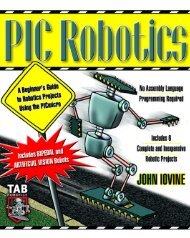Sensors and Methods for Mobile Robot Positioning
Sensors and Methods for Mobile Robot Positioning
Sensors and Methods for Mobile Robot Positioning
Create successful ePaper yourself
Turn your PDF publications into a flip-book with our unique Google optimized e-Paper software.
36 Part I <strong>Sensors</strong> <strong>for</strong> <strong>Mobile</strong> <strong>Robot</strong> <strong>Positioning</strong><br />
Obviously, there is no practical way to implement this theoretical arrangement, since a perfect<br />
mirror cannot be realized in practice. Furthermore, the introduction of light energy into the cavity<br />
(as well as the need to observe <strong>and</strong> count the nodes on the st<strong>and</strong>ing wave) would interfere with the<br />
mirror's per<strong>for</strong>mance, should such an ideal capability even exist. However, many practical<br />
embodiments of optical rotation sensors have been developed <strong>for</strong> use as rate gyros in navigation<br />
applications. Five general configurations will be discussed in the following subsections:<br />
& Active optical resonators (2.3.1).<br />
& Passive optical resonators (2.3.2).<br />
& Open-loop fiber-optic interferometers (analog) (2.3.3).<br />
& Closed-loop fiber-optic interferometers (digital) (2.3.4).<br />
& Fiber-optic resonators (2.3.5).<br />
Aronowitz [1971], Menegozzi <strong>and</strong> Lamb [1973], Chow et al. [1985], Wilkinson [1987], <strong>and</strong> Udd<br />
[1991] provide in-depth discussions of the theory of the ring-laser gyro <strong>and</strong> its fiber-optic<br />
derivatives. A comprehensive treatment of the technologies <strong>and</strong> an extensive bibliography of<br />
preceding works is presented by Ezekial <strong>and</strong> Arditty [1982] in the proceedings of the First<br />
International Conference on Fiber-Optic Rotation <strong>Sensors</strong> held at MIT in November, 1981. An<br />
excellent treatment of the salient features, advantages, <strong>and</strong> disadvantages of ring laser gyros versus<br />
fiber optic gyros is presented by Udd [1985, 1991].<br />
2.3.1 Active Ring Laser Gyros<br />
The active optical resonator configuration, more commonly known as the ring laser gyro, solves the<br />
problem of introducing light into the doughnut by filling the cavity itself with an active lazing<br />
medium, typically helium-neon. There are actually two beams generated by the laser, which travel<br />
around the ring in opposite directions. If the gyro cavity is caused to physically rotate in the<br />
counterclockwise direction, the counterclockwise propagating beam will be <strong>for</strong>ced to traverse a<br />
slightly longer path than under stationary conditions. Similarly, the clockwise propagating beam will<br />
see its closed-loop path shortened by an identical amount. This phenomenon, known as the Sagnac<br />
effect, in essence changes the length of the resonant cavity. The magnitude of this change is given<br />
by the following equation [Chow et al., 1985]:<br />
L 4%r 2 6<br />
c<br />
(2.2)<br />
where<br />
L = change in path length<br />
r = radius of the circular beam path<br />
6 = angular velocity of rotation<br />
c = speed of light.<br />
Note that the change in path length is directly proportional to the rotation rate 6 of the cavity.<br />
Thus, to measure gyro rotation, some convenient means must be established to measure the induced<br />
change in the optical path length.<br />
This requirement to measure the difference in path lengths is where the invention of the laser in<br />
the early 1960s provided the needed technological breakthrough that allowed Sagnac’s observations<br />
to be put to practical use. For lazing to occur in the resonant cavity, the round-trip beam path must




